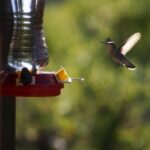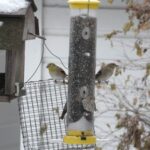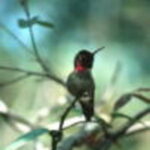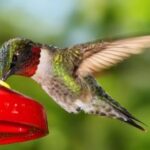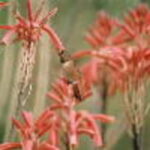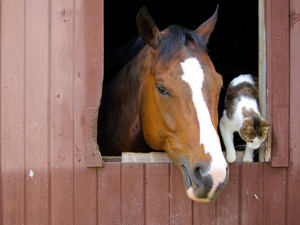Last year they never came, and the feeder was only a year old. It worked fine the year before. Several times, I took the feeder down, rinsed it, and refilled it. But no luck; no hummingbird stopped to suck from my feeder. But this year I’m ready and armed with hummingbird feeder wisdom. Here are ten tips I learned about hummingbird feeders by doing things incorrectly last year.
Tip #1: Attract with Bright Color
My hummingbird feeder faded in the sunshine of year one. Direct sunlight robbed it of the deep red color that would attract the hummingbirds. Since I had no flower color by the back door where I place it, it had to do all the hummingbird attracting on its own. It was too much for a faded pink feeder. This year calls for a new bright red one.
Tip #2: Place Out of Sunlight
Not only did direct sunlight fade the hummingbird feeder, but it encouraged mold growth inside the hummingbird feeder. Despite several attempts to clean the vessel before refilling it, I never quite got things right.
Tip #3: Wash and Rinse Correctly
Getting all the black mold spots out of my hummingbird feeder was vital to attracting the hummingbirds. Needless to say, my cleaning job was insufficient. A bottle brush or rice kernels in water would have helped remove those black mold spots. Instead, I used soapy water–not a good idea. The soap made the feeder drip more, and the hummingbirds didn’t like the residue. A white vinegar rinse of one part vinegar to five parts water, would have done wonders for my mold problem.
Tip #4: Avoid Red Dye
On my final attempt to attract hummingbirds last year, I added red food-grade dye to the water. Since then, I’ve learned that it’s not good for the hummingbirds. They eat about half their weight each day, and there is no knowing how much dye is too much dye for such a little bird. I could have just tied a red ribbon or bandanna on the feeder to bring on the color.
Tip #5: Make Nectar Correctly
One part table sugar (only) to four parts water is the standard hummingbird nectar recipe. Some people do one to three in early spring when few flowers are showing. The nectar is boiled 2 minutes on the stove top–to boil out any chlorine and dissolve the sugar. Then it is cooled and stored in a sanitized glass bottle in the refrigerator. Plastics leach; so avoid using a plastic container. Using a glass bottle with a small neck, makes filling the hummingbird feed much easier.
Tip #6: Fill it Full or Half-Full
My hummingbird feeder was large and I filled it full. A full feeder created the vacuum that kept it from dripping when the bottle was inverted. But it made me believe I could leave it as was, as long as it had nectar in it. Leaving it up for weeks encouraged mold spores to grow and detracted hummingbirds. Filling it half-full might have been a better choice.
During the hottest days, I needed to change the nectar every 3 days, rather than the usual four days. I hadn’t even come close to that average.
Tip #7: Keep Guards Clean
The bee, wasp, and ant guards that came with the hummingbird feeder needed to be thoroughly cleaned too. They had acquired mold, and the only thing hitting on a moldy feeder was wasps and bees. I had no ants, because the feeder hung from the eves of the house. The chain hung feeder also discouraged hungry cats from scouting out a tasty feathered morsel.
Tip #8: Safely Attract Hummingbirds
Where I placed my hummingbird feeder seemed safe enough, but the new patio umbrella and the house cut off view for the hummingbirds from two directions. They didn’t have full visibility and were probably skittish about coming in for the food. An open area of the yard would have been more suitable, giving them access and visibility from all directions.
Tip #9: Remember the Insects
Hummingbirds eat insects for protein. All I provided was sugar for energy. This year I’m putting a pot of red geraniums near the feeder for two reasons. The red color attracts the hummingbirds, and geraniums attract spiders.
Tip #10: Hummingbirds are Territorial
Hummingbirds are territorial. If I want more than a few hummingbirds to feed in my yard, I need more than one feeder, the feeders need to be out two weeks before hummingbirds make a showing, and then I need to wait patiently for the little birds.
If you enjoy watching hummingbirds feed, but you’ve had problems with your feeder, these tips should help. If you’ve never been entertained by lively little hummingbirds feeding, it’s worth putting up a feeder. With these tips, you’ll be attracting and keeping hummingbirds right from the start.
